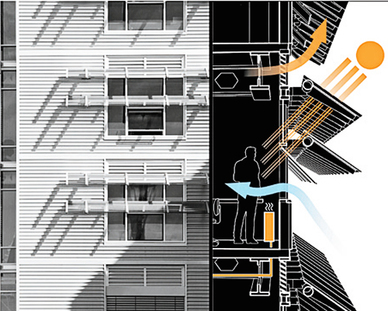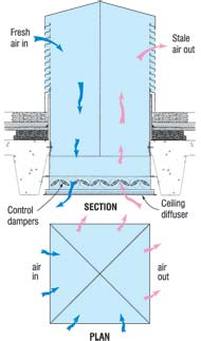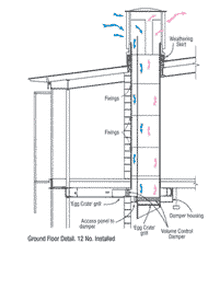NEW TECHNOLOGIES AND ARCHITECTURAL DESIGN
The key to any new technology being considered in design is one that will minimize heat loss whilst efficiently replacing used for fresh air. It should preferably make use of warm air for heating systems. A well thought out ventilation system is essential as it can be a main source of heat loss within a building.
FANS: Extractor fans are a common and cheap option. These would be placed in areas that would have humid areas and draw the air from the room.
STACK EFFECT: The design of a building can encourage natural forms of ventilation such as the stack effect. This sustainable method occurs by the cool air drawn into a building and heating, therefore becoming less dense, then rising usually through a chimney causing an upward air flow. It does not rely on wind and can clean the air in a building when the air is still and ventilation is most needed. This technique is frequently used in high-rise buildings.
STACK EFFECT: The design of a building can encourage natural forms of ventilation such as the stack effect. This sustainable method occurs by the cool air drawn into a building and heating, therefore becoming less dense, then rising usually through a chimney causing an upward air flow. It does not rely on wind and can clean the air in a building when the air is still and ventilation is most needed. This technique is frequently used in high-rise buildings.
WINDCATCHER: Wind driven ventilation such as windcatchers use natural ventilation. Windcatchers are situated on the roof of a building and use prevailing winds to create airflow in and out of the building. Wind enters and leaves through the different sections of the chimney; they also rely the stack effect and the changes in air pressure to work.
The chimneys can ventilate different floors of buildings by using internal divides and a fan system. This was used in the design of St. Annes School, Jersey, where windcatchers provide ventilation on both ground and first floor. Windcatchers can be used for the night-time cooling process.
The cool night air will draw the heat from the building naturally through the vents without the risk of security issues that open windows would bring about.
The chimneys can ventilate different floors of buildings by using internal divides and a fan system. This was used in the design of St. Annes School, Jersey, where windcatchers provide ventilation on both ground and first floor. Windcatchers can be used for the night-time cooling process.
The cool night air will draw the heat from the building naturally through the vents without the risk of security issues that open windows would bring about.
MVHR: The MVHR uses two fans to draw in fresh outside air and remove the used air simultaneously. The heat exchanger within the system heats the incoming air dramatically reducing the amount of energy used to heat the building. MVHR units can be wall or ceiling mounted. MVHR fans are quiet and can supply ventilation demands from 30 to 6000m³/h. The leading developer in the field of MVHR is PAUL Comfort Ventilation.




